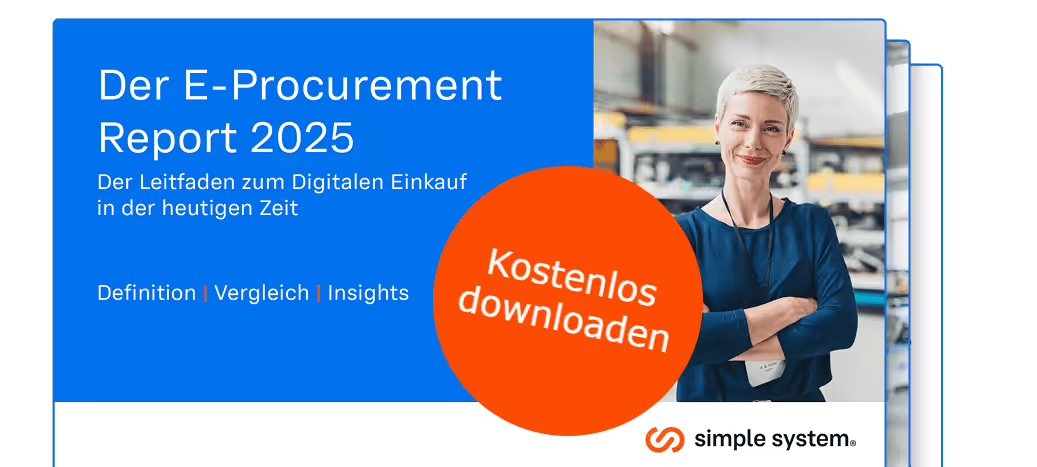Efficient procurement and warehousing ensure the flow of materials and reduce costs by avoiding overstocks and bottlenecks. Digital tools and optimized logistics strategies such as just-in-time delivery and automation ensure transparent and cost-effective processes.
Procurement & Warehousing: Advantages and Disadvantages for Companies
Purchasing and warehousing are closely linked and should not be viewed in isolation from each other. Both areas are important for a smooth flow of materials and the economic efficiency of a company. Together, they form the basis for a reliable supply of goods, optimized production processes and ultimately customer satisfaction.
What is warehousing? Definition and meaning.
Warehousing describes the systematic organization and administration of goods, raw materials or products in a company. The aim is to ensure availability in order to guarantee production and logistics without delays. It includes activities such as storage, monitoring, and transportation of materials.

What is the role of procurement in warehousing?
The Procurement process ensures that the right materials in sufficient quantity and quality find its way into the warehouse. Well-coordinated purchasing avoids excess inventory, which tie up space and capital, as well as bottlenecks that can cause production stops. By closely integrating purchasing and warehousing, companies make their processes more efficient and reduce their costs sustainably.
What are the different types of goods in warehousing?
In warehousing, a distinction is made between different types of goods in order to ensure a structured organization:
- raw materials: The basis for producing finished goods.
- Semi-finished products: Components that are further processed in the production process.
- finished goods: End products that are ready to be sold or shipped.
- Operating equipment: Tools and materials that are required for ongoing operation.
Spare parts: Components for machine repair and maintenance.

Advantages and disadvantages of warehousing
Well-thought-out and well-organized warehousing guarantees companies numerous advantages, such as smooth production and fast delivery times. However, storage errors — such as improper organization or poor scheduling — can also have significant disadvantages and impair efficiency.
What are the benefits of efficient warehousing?
Efficient warehousing in production is characterized by well-organized processes, optimized warehouse space and targeted use of technologies off. Inventory is managed in such a way that there are no excess stocks or bottlenecks, while at the same time minimizing storage costs and ensuring readiness for delivery. The benefits of effective warehousing are:
- Cost savings
- higher readiness to deliver
- improved inventory overview
- saving time
- flexibility
- lower error rate
What are the disadvantages and risks of warehousing?
Chaotic warehousing is characterized by lack of organization, inadequate security measures and inefficient processes off. This can result in the following disadvantages and risks:
- damage to goods
- increased risk of fire or water damage
- higher injury potential in the workplace
- Retention or spoilage of products
- higher costs due to inefficient use of space
- increased maintenance costs
- Overstocks or shortages
Resource management in procurement and warehousing
Resource management is a central part of modern corporate management. It comprises the efficient design, use, and monitoring of resources such as materials, time, and manpower to achieve economic and sustainable goals. Well-structured resource management in purchasing and warehousing improves productivity and reduces waste.
What can optimal resource planning look like?
Optimal resource planning requires transparency about inventories, requirements, and procurement cycles. Digital tools such as simple system make these processes easier by providing relevant data in real time. With functions such as automated ordering processes, integrated supplier management and inventory monitoring, the platform helps to avoid excess inventory and minimize supply bottlenecks. Such solutions help companies to manage their warehousing strategically and expediently without wasting valuable resources.

Delivery and logistics in warehousing
Delivery is an essential part of warehousing, as it directly influences the flow of materials and the availability of goods. Optimized delivery processes reduce delays and improve customer satisfaction. Logistics plays a decisive role in this by designing transport routes, storage areas and delivery times in such a way that costs and time are minimized. A smooth Procurement logistics is therefore the key to a functioning warehousing system.
How does the material flow in the warehouse work?
The flow of goods in the warehouse comprises all processes from incoming goods to outgoing goods:
- Receipt of goods: The delivery is checked, registered and stored.
- Warehousing: Articles are stored at defined storage locations.
- Commissioning: Products are assembled and removed in accordance with customer or production orders.
Outgoing goods: orders are packaged, labelled and ready for shipping.

Which logistics strategies improve delivery?
With the following logistics strategies Is the inventory condition significantly improved in companies with regard to the delivery and storage of goods:
- Just-in-time delivery: Production equipment is delivered exactly when needed, which reduces inventory costs.
- Cross-docking: Goods are ready for dispatch immediately after receipt of the goods, without having been stored first.
- automation: Use of robots or conveyor belts to speed up internal transport routes.
- Route optimization: Software-supported organization of the shortest and most efficient delivery routes.
How can storage and retrieval be optimized?
Tools such as simple system offer solutions for a more productive storage and retrieval. With automated workflows, warehouse movements can be digitally documented, and intelligent algorithms ensure that products can be found quickly and easily. Die Procurement platform It also enables the integration of supplier information, which makes it easier to plan and track inventory. This not only makes inventory management easier, but also more cost-effective.
Synopsis
A promising sourcing and warehousing are crucial to a company's success. While a structured resource planning save time and money, optimize well-thought-out logistics strategies in the movement of materials. Tools such as simple system facilitate these processes through digital support and create transparency throughout the supply chain.
Frequently asked questions
What are the best practices for warehousing companies?
A clear structure, regular inventory checks and the use of digital tools ensure effective warehousing.
What are the best inventory management tools?
Digital warehouse management systems, automation tools and real-time analyses are essential for successful warehouse management and a well-organized library.
How do you effectively sort products in the warehouse?
Products are sorted according to the ABC analysis principle, in which frequently used items are stored closer to the picking areas.
Which strategies help to compensate for fluctuations in inventory?
Buffer stocks, flexible supply agreements and proactive demand planning minimize inventory fluctuations.
Are there tools that help create warehouse strategies?
Tools such as simple system offer solutions for more effective and easy storage and retrieval. With automated workflows, warehouse movements can be digitally documented, and intelligent algorithms ensure that products can be found quickly and easily. The platform also enables the integration of supplier information, which makes it easier to plan inventory levels and track them. This not only makes inventory management easier, but also more cost-effective.

Einkaufen & sparen
Erfahren Sie, wie es geht, in unserem kostenlosen E-Procurement-Report. Jetzt kostenlos und unverbindlich herunterladen.
Jetzt lesen








